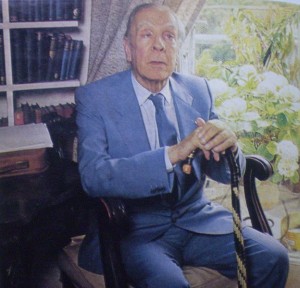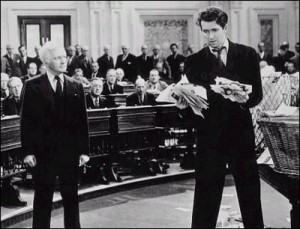
I just finished teaching, in my last few classes of this term, a number of the remarkable pieces of fiction in Jorge Luis Borges’ Labyrinths. The more I return to the great Argentinian writer the more I see the deep affinities between his work and another writer I have grown more and more fascinated with, Edgar Allan Poe, “the greatest literary genius this side of William Blake,” according to Frye. Frye speaks of Poe admiringly in Anatomy as being a much more radical and uninhibited archetypal abstractionist than his contemporary romanticist Hawthorne. He means by this that Poe dispenses with the normal constraints of logic, realism, and conventional morality that hobbled a writer like Hawthorne and made him feel he had to contain the world of Ideality within the confines of a morally responsible allegory. Unlike Hawthorne, however, Borges, like Poe, utterly disregarded any “general distinction between serious and responsible literature on the one hand, and the trifling and fantastic on the other.” As Frye points out, such distinctions
are not literary categories, or qualities inherent in literary works themselves. They are the primary elements of the social acceptance of or response to literature. Hence what is accepted as serious or dismissed as trifling may vary from one age to another, depending on currents of fashion or cultural attitudes operating for the most part outside literature.
Because he so thoroughly abandoned any such sense of responsibility or seriousness, Poe was able to give himself over completely to a trust in his own imaginative life. Borges followed his own imaginative instincts in the same way. Both writers exemplify the idea of “pure” literature and the sheer power of the conceivable.
In the opening chapter of Words with Power, Frye outlines the sequence of modes that make up the verbal universe and shows how each mode (the descriptive, conceptual, rhetorical, imaginative, and kerygmatic) is founded on an excluded initiative, an aspect of the power of words it must deny in order to assert its own ascendent authority. Thus the mythological or imaginative is the excluded initiative of dogma and ideology, and the excluded initiative of the imaginative is the kerygmatic or anagogic, the world of the meta-literary, a prophetic mode responsive to both the existential and the spiritually transcendent. However, the latter is not a negation of the literary, but literature plus: there is not spiritual reality which is not also an imaginative vision. Perversely, with the current dogmatic hegemony of post-structuralism and cultural studies the imaginative is precisely what is excluded from study by many contemporary critics and scholars. It is against this dogmatic tendency, whether from the right or the left, that writers like Poe and Borges assert and champion the pure autonomy of the imagination.
Literature, Frye writes, is the product of
the need for a more inclusive mode of verbal communication of a type that since the Romantic period has usually been called imaginative. Such a mode takes us into a more open-ended world, breaking apart the solidified dogmas that ideologies seem to hanker for.
An imaginative response is one in which the distinction between the emotional and the intellectual has disappeared, and in which ordinary consciousness is only one of many possible psychic elements, the fantastic and the dreamlike having conventionally an equal status. The criterion of the imaginative is the conceivable, not the real, and it expresses the hypothetical or assumed, not the actual. It is clear that such a criterion takes us into the verbal area we call literature.
Nowhere is this criterion of the conceivable and the hypothetical more fully at the centre of a writer’s concern than in Borges’ work where the imaginative or subjective element of dreaming and fantasy reigns supreme. In perhaps his most famous tale, “The Garden of Forking Paths,” the universe is conceived of as a laybrinthine temporal multi-verse, a maze of time consisting of potentially infinite alternative story-lines: the legendary garden of the demiurge Tsui Pen is in fact a book, a work of fiction (compare Mallarme’s “le monde va s’aboutir a un livre”). It is a parable “whose theme is time,” an image of the universe as “an infinite series of time, in a growing, dizzying net of divergent, convergent and parallel times, of the universe as embracing “all possibilities of time.”
Another story, “The Circular Ruins,” concerns the paradoxical relationship between illusion and reality, creator and creature: a man arrives on the shores of a deserted part of the jungle, where there is a circular ruin, apparently a demolished temple, “long ago drowned by fire”: he is a shaman, a magus, who has come to this place to invoke the power of the fire god in order to engage in the demiurgic feat of creating a man: to do so he must “dream” a man and then insert him, by the fullest concentration of his mind, into reality. After great struggle he succeeds in his task, but suffers from the awareness that his child must some day be awakened to the knowledge that he is nothing but a dream. However, he is now an exhausted old man, ready for death, and as a conflagration engulfs the rebuilt temple of the fire god he stoically walks into the flames. Not feeling any pain, he realizes that he is himself the dream of another man, who is, according to an ironic infinite regress, perhaps himself a dream of someone else, who is dreaming of a man who creates a man by dreaming: “Not to be a man, to be the projection of another man’s dream, what a feeling of humiliation, of vertigo!”
In Borges, the hypothetical and virtual always trump reality. In one of my favorite “ficciones,” “Tlön, Uqbar, Orbis Tertius,” the narrator and his friend and alter ego discover the existence of a complex, centuries-old fictional project undertaken in secret by an elite group of illuminati to create a completely illusory and fictional world: the discovery of a hoax in an encyclopedia about a country called Tlön leads to the further, astonishing discovery of an entire planet intricately imagined and recorded in an encyclopedia : the fiction is so successful that what is thus imagined takes on the force of an inexorable pressure on the existing world as the fictional universe begins to insert itself into reality.
The impossible, the non-existent, the unreal is actualized, in much the same way as described by Rilke in Sonnets to Orpheus (sonnet 2 of the second part), in which a the purely hypothetical creature, the unicorn, appears at least by virtue of those who lovingly imagined it and fed it “only with the possibility that it truly was”:
O this is the creature that does not exist.
They knew nothing and yet without a doubt
—his gait, his posture, his neck, down
to the silent light of his gaze—they had loved.
Indeed, it wasn’t real. But because they loved,
it became a pure animal. Always, they gave it space.
And in that space, clear and spare
it raised lightly its head and needed scarcely
to be. They nourished it not with grain,
but with only the possibility that it truly was.
And this gave such strength to the animal
that it grew a horn from its brow. But one horn.
It passed in its whiteness a young maiden—
and appeared in the silver mirror, and in her.
Borges’ writings, like Frye’s criticism, are always laid on the surest of foundations: the bedrock substance of the possible, the conceivable, the imaginable– creators of the real.






